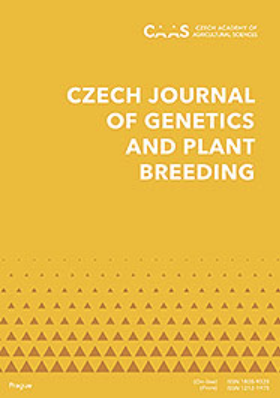西藏无壳大麦HvnHID基因的分离、测序及其在紫色粒色发育中的作用
IF 1.8
4区 农林科学
Q3 AGRONOMY
引用次数: 2
摘要
2-羟基异黄酮脱水酶(HID)在异黄酮的生物合成中起着重要作用。本研究从紫粒西藏无壳大麦品种Nerumuzha和白粒西藏无壳大麦品种昆仑10号的种子中分离出HID。hhnhid基因包括981 bp的开放阅读框,编码327个氨基酸的蛋白质。它具有典型的Abhydrolase_3结构域(78-306),属于Abhydrolase_3 (α/β水解酶)超家族的羧酸酯酶(CXE)家族。在hnnhid编码序列上,Nerumuzha和Kunlun 10存在8个核苷酸差异和2个氨基酸差异(1个在Abhydrolase_3结构域)。无壳大麦的hnhid与普通大麦的亲缘关系最密切,与哈利大麦的亲缘关系最远。在种子颜色发育早期和中期,紫色和黑色种子中hnvhid的表达量极显著高于白色和蓝色种子(P < 0.01)。紫粒无壳大麦种子色发育过程中,花青素生物合成途径关键基因HvnF3'H、HvnDRF、HvnANT1和HvnGT的表达量显著升高,而HvnHID的表达量显著降低(P < 0.01)。因此,hnhid可能负调控花青素的生物合成。该结果为进一步研究hhnhid在花青素生物合成途径中的生物学功能提供了重要依据。本文章由计算机程序翻译,如有差异,请以英文原文为准。
Isolation, sequencing of the HvnHID gene and its role in the purple-grain colour development in Tibetan hulless barley
2-hydroxyisoflavanone dehydratase (HID) plays an important role in isoflavone biosynthesis. In this study, HID was isolated from the seeds of the purple-grained Tibetan hulless barley variety Nerumuzha and the white-grained variety Kunlun 10. The HvnHID gene includes the 981 bp open reading frame and encodes a protein of 327 amino acids. It has a typical Abhydrolase_3 domain (78–306) and belongs to the carboxylesterase (CXE) family of the Abhydrolase_3 (α/β hydrolase) superfamily. There are eight nucleotide differences in the HvnHID coding sequence and two amino acid differences (one in the Abhydrolase_3 domain) between Nerumuzha and Kunlun 10. The HvnHID of hulless barley has the closest relationship with the HID in Hordeum vulgare, and the most distant relationship in Panicum hallii. At the early-mid stage of the seed colour development, the HvnHID expression levels in the purple and black seeds were significantly higher than in the white and blue ones (P < 0.01). During the seed colour development of purple-grained hulless barley, the expression of the key genes (HvnF3'H, HvnDRF, HvnANT1, and HvnGT) in the anthocyanidin biosynthetic pathway increased significantly, while the HvnHID expression decreased significantly (P < 0.01). Thus, it is likely that HvnHID negatively regulates the anthocyanidin biosynthesis. This result provides an important basis for further study of the biological functions of HvnHID in the anthocyanidin biosynthetic pathway.
求助全文
通过发布文献求助,成功后即可免费获取论文全文。
去求助
来源期刊

Czech Journal of Genetics and Plant Breeding
Agricultural and Biological Sciences-Plant Science
CiteScore
2.20
自引率
0.00%
发文量
25
审稿时长
>12 weeks
期刊介绍:
Original scientific papers, critical reviews articles and short communications from the field of theoretical and applied plant genetics, plant biotechnology and plant breeding. Papers are published in English.
 求助内容:
求助内容: 应助结果提醒方式:
应助结果提醒方式:


